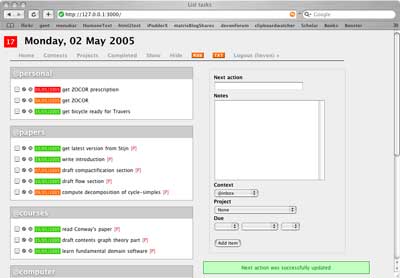
I just
started putting my mind on tracks but it will take
me a couple of days to offload most of the crap that keeps me awake at
night. There are three main components to Tracks: Next actions, Contexts
and Projects.
“Contexts are very flexible, and can
be places, states of mind or modes of working in which actions can be
taken. Next actions can be assigned to and sorted by context so that you
know when you are able to make progress with items. e.g. “Library”,
“Shops” or “Tired”.” So far I added only 10 contexts : _@inbox_,
_@books_, _@email_, _@home_, _@neverending_,
_@courses_, _@other_, _@papers_, _@computer_
and _@personal_. Probably I’ll have to add others such as
_@refereeing_ etc.
“Projects : any goal
which requires more than one next action to take it to completion is a
Project. In Tracks, you can view your next actions by Project.” So far I
added the first few things that came to mind ranging from small-easy
things such as _Learn
VoodooPad_ over _Paper with Jan_ to neverending-things
like Write nag@n !
“Next
actions : These are the heart of GTD. They are the very next
physical action that can be taken on something. It’s best to phrase
these in an active way e.g. “Call Bob about the committee meeting” or
“Search for a reputable garage”.” Up to now I merely added the next
foreseeable action in each project together with a few urgent persoanl
matters. It is a good idea to give each of these a deadline so they
appear on the screen with a color-code giving the date and red (urgent),
orange (coming up) to green (some day). I realize I’ve been rather
relaxed about my projects so far!
More information on tracks can
be found here. Try it
out!